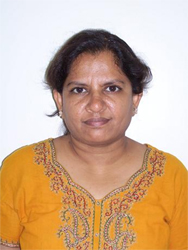|

|
MAHADEVAN Priya
Physics
S.N. Bose National Centre for Basic Sciences
India |
Dr. Priya Mahadevan, born in India in 1970, receiving her B.Sc in Bangalore University in 1991, and then she finished her M.Sc in 1992 and Ph.D in 1998 in Indian Institute of Science. She is a Condensed Matter theorist working as an Associate Professor at S.N.Bose National Centre for Basic Sciences, Kolkata. Her interests encompass the study of properties of materials using a combination of tools.
Dr Mahadevan has a very good academic record. She was awarded the fifth rank in Bangalore University for her Bachelor's degree. Following this achievement, she was one of six students selected on the basis of a national- level examination to join the prestigious Integrated PhD program at the Physics Department of the Indian Institute of Science (IISc), Bangalore. This is a combined Master of Science and PhD programme. She worked for a PhD in the group of Professor D.D. Sarma at the Solid State and Structural Chemistry Unit, IISc using a combination of ab-initio and model Hamiltonian tools, some of which were developed by her during the course of her PhD. Her work towards a PhD was well recognized and she received the L.A. Meera Prize for Best Thesis in the Physics Department as well as the Martin Foster Medal for the Best Thesis in the Physical and Mathematical Sciences Division at IISc.
Dr. Mahadevan worked as a post-doctoral associate in the group of professor Terakura in Japan for two years, where she worked on the properties of manganites. This was followed by a short stint of six months in the group of Professor D.D Sarma at the Indian Institute of Science, Bangalore on the electronic and magnetic properties of double perovskite oxides. She then joined the group of Professor Alex Zunger at the National Renewable Energy Laboratory, Golden, USA where she worked on various aspects of magnetism in dilute magnetic semiconductors.
After close to three years in the group of Professor Zunger, Dr Mahadevan joined the Department of Physics, Indian Institute of Technology at Chennai as an Assistant Professor. In 2005 she moved to the S.N.Bose National Centre for Basic Sciences, Kolkata where she currently heads a group that includes six PhD students and a post-doctoral associate. Her first PhD student has graduated and is now doing a post-doctoral associateship in the theoretical nanostructures group of Professor Gabriel Bester at Max-Planck Institute, Stuttgart.
Dr. Priya Mahadevan is an accomplished young condensed matter theorist working as an Associate Professor at S.N. Bose National Centre for Basic Sciences, Kolkata. Although she is under forty, she has authored over 60 papers many of which represent significant contributions in the study of electronic and magnetic properties of materials. The impact of her work can be appreciated in terms of a short, quantitative description of her publications - she has published 7 Physical Review Letters (the highest related Physics journal), 25 Physical Review B (undoubtedly the most renowned journal dedicated to condensed matter physics), 4 Applied Physics Letters (the leading journal in the area of applied Physics), among others. Her publications have been cited nearly 1000 times, indicating how often subsequent work relied on her earlier scientific contributions with an H- index of I4; these numbers are undoubtedly among the very best in her peer group, not only on the basis of her gender or the economic development of her country. Any scientist of her age group even in the developed world will be proud to have achieved so much at such a young age.
A key component of her research has been in using first principle electronic structure calculations to construct basic models for magnetism. In the case of the double perovskite oxide Sr2FeMoO6, she with coworkers showed that the hopping between Fe and Mo sites mediates an exchange pathway which allows the ferromagnetic ordering of Fe spins resulting in a very high Curie temperature in a material in which the magnetic spins are far separated. This appeared in Phys. Rev. Lett. 85,2549 (2000).
Later it was observed that the generic features of the model could be extended to encompass other systems also. The recently discovered dilute magnetic semiconductors were one such class of compounds where the model found applicability. A detailed analysis of the ab-initio results comparing with the existing models for magnetism appeared in Phys. Rev. B 69, 115211 (2004) and Phys. Rev. Lett. 93,177201 (2004). Some concrete predictions of the model were found to be supported by first principle calculations. Any theoretical model could do with experimental verification. This was indeed found to be the case by the group of Yazdani at Princeton University (See Nature News and Views 442, 359 (2006)). Her recent interests have moved to a search of d0 magnetism - examples of magnetic materials which have no transition metal atom. Her paper (Phys. Rev. B 73, 153201 (2006)) on the large exchange splitting for Ga vacancies in GaN was one of the earliest in the field of defect-induced magnetism. She has since explored alternate routes to d0 magnetism and her research has uncovered an entire class of less explored alkali oxides which not only exhibit magnetism, but also exhibit orbital ordering.
Her research is carried out in close contact with experiments. Resonant x-ray scattering was proposed as an important experimental tool in determining the presence of charge and orbital ordering. Her work on La0.5Sr1.5MnO4 showed for the first time the extreme sensitivity of the experimental probe to lattice distortions over actual charge imbalance. This had important implications on the theoretical understanding of charge and orbital ordering. This appeared in Phys. Rev. Lett. 87, 066404 (2001).

